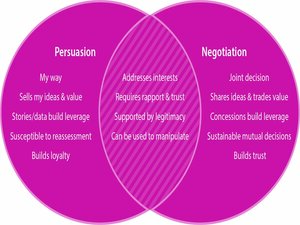Course Overview
You can get others to do things by using coercion, manipulation, and threats, but the long-term implications of such tactics might be bad for coworkers’ interactions. This persuasion and influence course focuses on useful methods and strategies for influencing people to act, encouraging group problem-solving, eliminating prejudices, and using interpersonal skills to motivate individuals. Participants in this participatory workshop will examine a variety of models, concepts, and methods to improve their capacity to persuade people to act voluntarily rather than under duress.
Course outcomes
- Describe the differences between coercion and manipulation and influence and persuasion.
- Describe how values and beliefs are created.
- Provide a variety of tools for persuasion.
- Provide suggestions for overcoming prejudices.



Course Objectives
- Describe the importance of persuasion and influence.
- Describe the decision-making process.
- Describe the relationship between attitudes, values, and behaviors.
- Talk about the Johari Window as a conceptual framework for comprehension of disclosure.
- Use both push and pull techniques for influence.
- Describe the six influence principles proposed by Dr. Robert Cialdini.
- Describe how biases affect decisions and offer strategies for identifying, minimizing, and eliminating them.
Organizational advantages
- Creating a marketing intelligence system using the relevant data
- Ensuring effective administration of integrated marketing communications
- Improved after-sales and sales services
- Increased market share increased likelihood of sticking out from the competition improved market image development
- Greater likelihood of repeat business
- Collecting more effective sales promotion methods
Personal advantages
- Being more capable in the role of selling
- Having the ability to explain and demonstrate products
- Timely reaching set sales goals
- Recognizing the value of preparation before making a transaction
- Collaborating with employees from many areas around the firm
- Analysis of statistical data to enhance understanding of consumer base and historical sales
Sales Training Highlights
Training Feedback
Happy Customers
Course Outline
Understanding the Power of Persuasion and Influence
This course begins with a consideration of influence and persuasion and how they vary from coercion and manipulation. The next step is for participants to list the individuals who have impacted them throughout the years as well as the groups they now want to influence and why. The process of decision-making and the value of appealing to the head, the heart, the hands, or a mix of the three will be discussed next.
Try to Understand It My Way: How Beliefs Develop
All of our words and deeds are built on our beliefs. They have an impact on morals and conduct. In this segment of the program, we’ll look at a model that describes how attitudes, values, and beliefs affect behavior. Participants will develop a values map on their own. This activity will highlight the variations present in the classroom and how they reflect the variety of worldviews present. Following completion of the influencing-styles evaluation, participants will discuss their favorite styles, the benefits and drawbacks of each style, and the circumstances in which each provides a tactical advantage.
To Understand While You See It Your Way
If you don’t know where another person is coming from, you can’t affect them in a focused way. Building rapport, mirroring, questioning techniques, and reflective listening are the main topics of this seminar part. We will also look at the Johari Window, a concept developed in the 1950s by psychologists Joseph Luft and Harry Ingham, during this portion of the program. They describe different levels of self-awareness and exposure in their paradigm. The size of the window’s panes and our capacity to establish a sincere connection with and subsequently sway other people will be discussed about trust and its absence.
I’ll thus ask you again: Pull or Push
Influencers must decide whether to take a push or a pull strategy depending on the scenario and circumstances. This course assignment examines both possibilities and the circumstances under which they are appropriate. We will then examine the six principles of influence proposed by Dr. Robert Cialdini and the instances of each. Then, participants will take into account several case studies and develop a strategy for dealing with the issues they raise.
We Might Disintegrate Soon: Examining Bias
A bias is a limited viewpoint or a favored perspective of the world, and these preferences frequently ignore equally valid alternatives. Biases are examined in this section of the course along with how they may impact perception. We will look at 25 prevalent biases and methods for identifying, minimizing, and eliminating them.
Participants should leave this influence and persuasion training program with a good awareness of their alternatives for influencing others’ thoughts and behavior.
Who Should Attend
- Senior marketing directors or managers
- Relationship managers and
- Customer relationship managers
- Professionals in customer service, supervisors,
- Team leaders, and managers
- Sales experts, salespeople, and sales analysts
- Entrepreneurs and founders of startups
Trainers Available for:
- In-House Trainings
- Online Training
- 2 Hours Crush Program
- Half Day Program
- One Day Program
- Two Days Full Program
Training Techniques
- Power point Presentations
- Engaging conversations
- Case studies
- Exercises in solving problems
- Focus Group Conversations
- Games in Management
- Skits and modeling the part
Request a Quote

